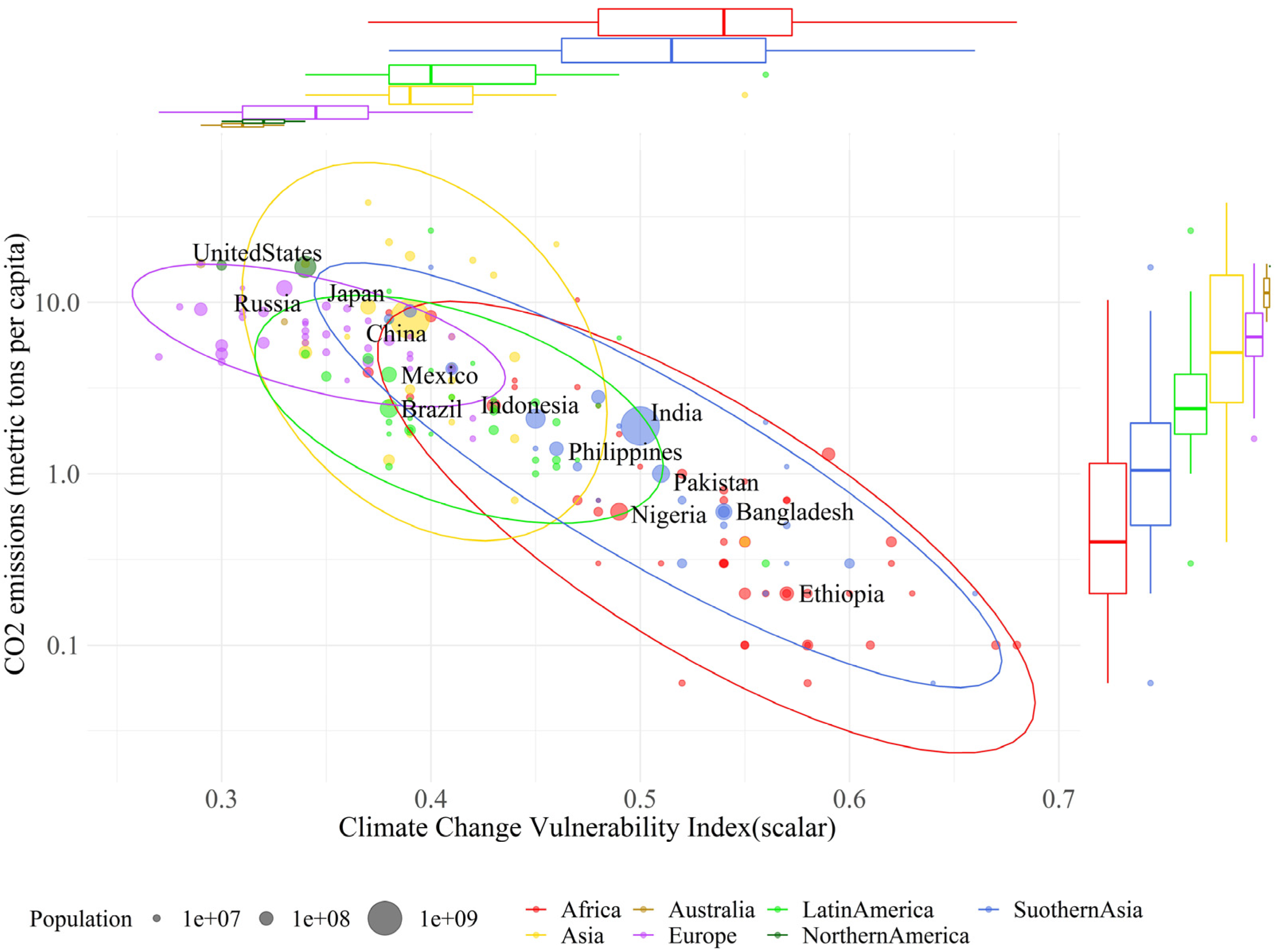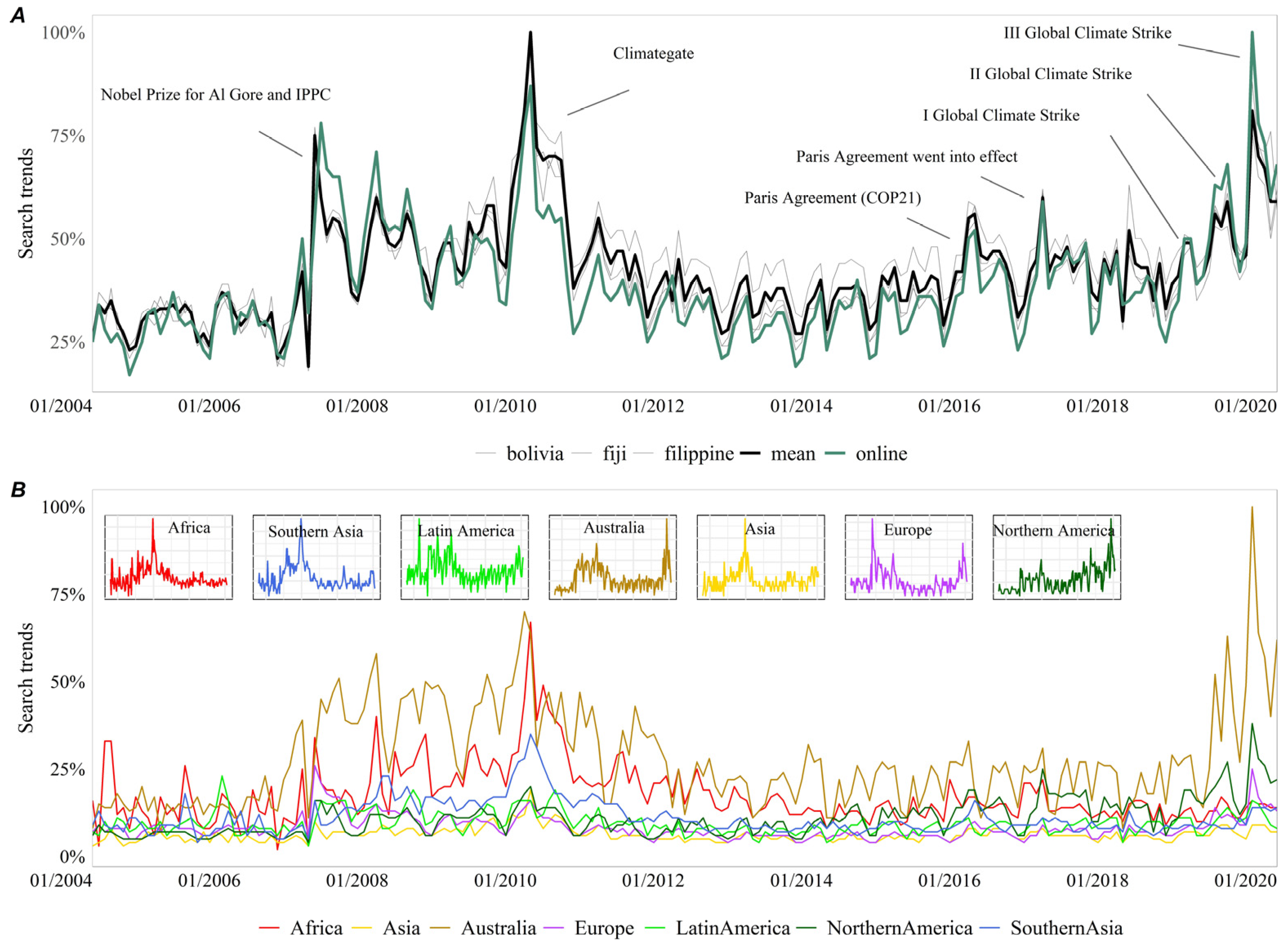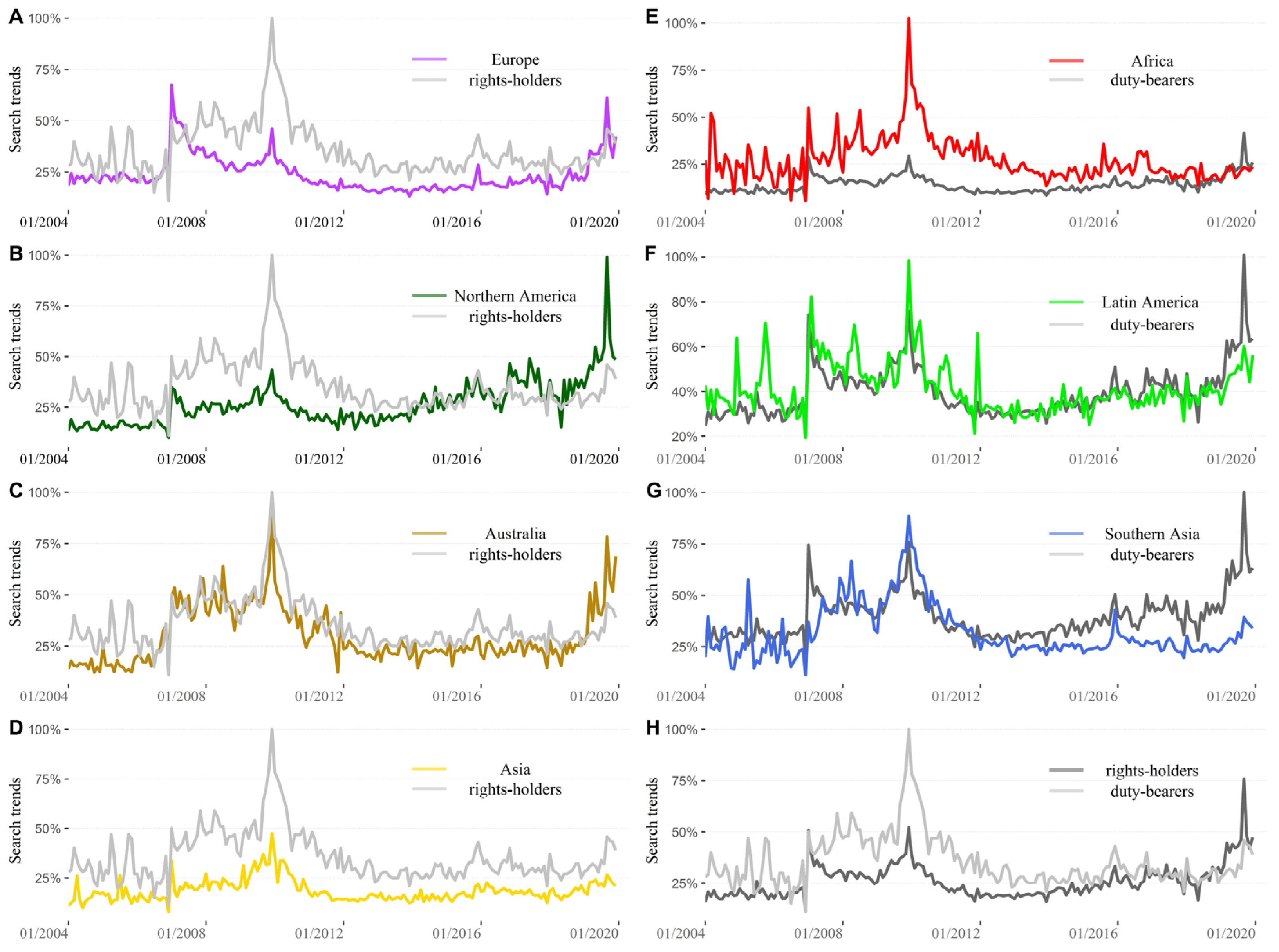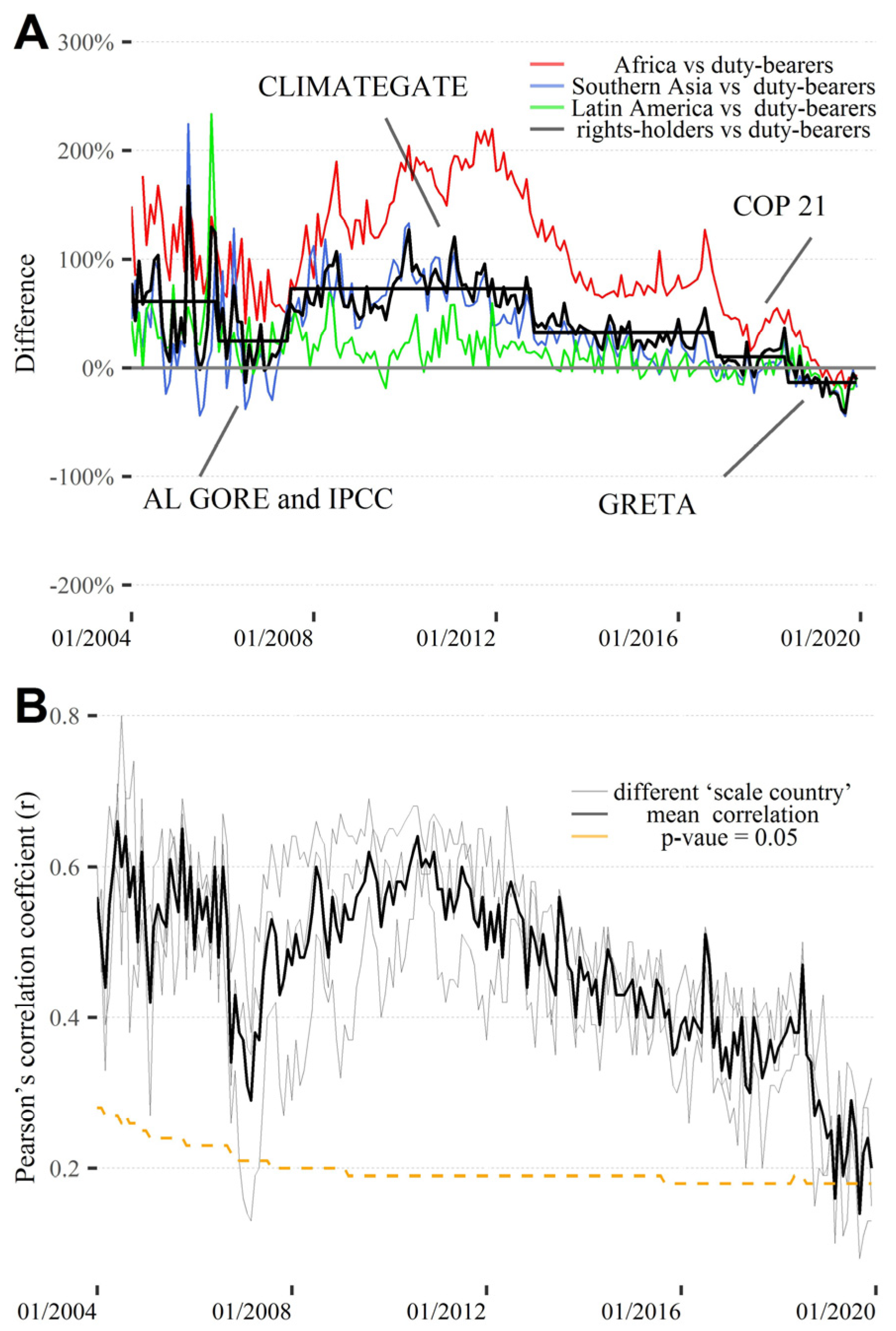The Greta Thunberg Effect on Climate Equity: A Worldwide Google Trend Analysis
Abstract
1. Introduction
2. Materials and Methods
2.1. Survey on Worldwide Climate Change Awareness
2.2. Comparison between Google Searches and Survey Data
2.3. Climate Vulnerability Scores
2.4. Carbon Dioxide Emissions
2.5. Geographical Grouping of Duty-Bearers and Rights-Holders
3. Results
3.1. What Do Google Searches on Climate Change Mean?
3.2. Climate Equity and Economic Equity: Duty-Bearers and Rights-Holders
3.3. Geographic Grouping of Google Trends Data
4. Discussion
4.1. The History of Public Interest in Climate Change
4.2. What Is the “Greta Thunberg Effect” on Climate Equity?
5. Conclusions
Supplementary Materials
Funding
Institutional Review Board Statement
Informed Consent Statement
Data Availability Statement
Acknowledgments
Conflicts of Interest
References
- Kühne, R.W. Climate Change: The Science behind Greta Thunberg and Fridays for Future. 2019. Available online: https://doi.org/10.31219/osf.io/2n6kj (accessed on 15 February 2023).
- Jonathan, W. The Guardian. 2019. Available online: https://www.theguardian.com/environment/2019/apr/23/greta-thunberg (accessed on 15 February 2023).
- Jung, J.; Petkanic, P.; Nan, D.; Kim, J.H. When a girl awakened the world: A user and social message analysis of Greta Thunberg. Sustainability 2020, 12, 2707. [Google Scholar] [CrossRef]
- Han, H.; Ahn, S.W. Youth mobilization to stop global climate change: Narratives and impact. Sustainability 2020, 12, 4127. [Google Scholar] [CrossRef]
- Martiskainen, M.; Axon, S.; Sovacool, B.K.; Sareen, S.; Del Rio, D.F.; Axon, K. Contextualizing climate justice activism: Knowledge, emotions, motivations, and actions among climate strikers in six cities. Glob. Environ. Chang. 2020, 65, 102180. [Google Scholar] [CrossRef]
- Thanki, N. The World at 1 °C. 2019. Available online: https://worldat1c.org/what-does-greta-thunberg-mean-when-she-says-equity-8a0d880e8448 (accessed on 15 February 2023).
- OHCHR. Key Messages on Human Rights and Climate Change. 2015. Available online: http://www.ohchr.org/Documents/Issues/ClimateChange/KeyMessages_on_HR_CC.pdf (accessed on 15 February 2023).
- Althor, G.; Watson, J.E.; Fuller, R.A. Global mismatch between greenhouse gas emissions and the burden of climate change. Sci. Rep. 2016, 6, 20281. [Google Scholar] [CrossRef]
- Pauw, W.P.; Klein, R.J.; Mbeva, K.; Dzebo, A.; Cassanmagnago, D.; Rudloff, A. Beyond headline mitigation numbers: We need more transparent and comparable NDCs to achieve the Paris Agreement on climate change. Clim. Chang. 2018, 147, 23–29. [Google Scholar] [CrossRef]
- Grecequet, M.; Saikawa, E.; Hellmann, J.J.; Kapuscinski, A.R.; Locke, K.A.; Hoffman, A.J. Select but diverse countries are reducing both climate vulnerability and CO2 emissions. Elem. Sci. Anthrop. 2019, 7, 4. [Google Scholar] [CrossRef]
- Fussel, H.-M. How inequitable is the global distribution of responsibility, capability and vulnerability to climate change: A comprehensive indicator-based assessment. Glob. Environ. Chang. 2010, 20, 597–611. [Google Scholar] [CrossRef]
- Burstein, P. The impact of public opinion on public policy: A review and an agenda. Political Res. Q. 2003, 56, 29–40. [Google Scholar] [CrossRef]
- Burstein, P. Why estimates of the impact of public opinion on public policy are too high: Empirical and theoretical implications. Soc. Forces 2006, 84, 2273–2289. [Google Scholar] [CrossRef]
- Rasmussen, A.; Mäder, L.K.; Reher, S. With a little help from the people? The role of public opinion in advocacy success. Comp. Polit. Stud. 2018, 51, 139–164. [Google Scholar] [CrossRef]
- Burivalova, Z.; Butler, R.A.; Wilcove, D.S. Analyzing Google search data to debunk myths about the public’s interest in conservation. Front. Ecol. Environ. 2018, 16, 509–514. [Google Scholar] [CrossRef]
- Lu, F.S.; Hattab, M.W.; Clemente, C.L.; Biggerstaff, M.; Santillana, M. Improved state-level influenza nowcasting in the United States leveraging Internet-based data and network approaches. Nat. Commun. 2019, 10, 147. [Google Scholar] [CrossRef]
- Pierron, D.; Pereda-Loth, V.; Mantel, M.; Moranges, M.; Bignon, E.; Alva, O.; Kabous, J.; Heiske, M.; Pacalon, J.; David, R.; et al. Smell and taste changes are early indicators of the COVID-19 pandemic and political decision effectiveness. Nat. Commun. 2020, 11, 5152. [Google Scholar] [CrossRef] [PubMed]
- Zhong, X.; Raghib, M. Revisiting the use of web search data for stock market movements. Sci. Rep. 2019, 9, 13511. [Google Scholar] [CrossRef] [PubMed]
- Li, X.; Law, R.; Xie, G.; Wang, S. Review of tourism forecasting research with internet data. Tour. Manag. 2021, 83, 104245. [Google Scholar] [CrossRef]
- Ficetola, G.F. Is interest toward the environment really declining? The complexity of analysing trends using internet search data. Biodivers. Conserv. 2013, 22, 2983–2988. [Google Scholar] [CrossRef]
- Correia, R.A. Google trends data need validation: Comment on Durmuşoğlu (2017). Hum. Ecol. Risk Assess. 2019, 25, 787–790. [Google Scholar] [CrossRef]
- Correia, R.A.; Di Minin, E.; Jarić, I.; Jepson, P.; Ladle, R.; Mittermeier, J.; Roll, U.; Soriano-Redondo, A.; Veríssimo, D. Inferring public interest from search engine data requires caution. Front. Ecol. Environ. 2019, 17, 254–255. [Google Scholar] [CrossRef]
- Stokes, B.; Wike, R.; Carle, J. Global Concern about Climate Change, Broad Support for Limiting Emissions: US, China Less Worried; Partisan Divides in Key Countries. Pew Research Center Research Report, 5. 2015. Available online: https://www.pewresearch.org/global/2015/11/05/global-concern-about-climate-change-broad-support-for-limiting-emissions/ (accessed on 15 February 2023).
- Carvalho, L. An Improved Evaluation of Kolmogorov s Distribution. J. Stat. Softw. 2015, 65, 1–8. [Google Scholar] [CrossRef]
- R Core Team. R: A Language and Environment for Statistical Computing. R Foundation for Statistical Computing Website. 2020. Available online: https://www.eea.europa.eu/data-and-maps/indicators/oxygen-consuming-substances-in-rivers/r-development-core-team-2006 (accessed on 15 February 2023).
- Chen, C.; Hellmann, J.; Berrang-Ford, L.; Noble, I.; Regan, P. A global assessment of adaptation investment from the perspectives of equity and efficiency. Mitig. Adapt. Strat. Glob. Chang. 2018, 23, 101–122. [Google Scholar] [CrossRef]
- Chen, C.; Noble, I.; Hellman, J.J.; Coffee, J.; Murillo, M.; Chawla, N. Country Index Technical Report. University of Notre Dame Global Adaptation Index. South Bend, USA. 2015. Available online: https://gain.nd.edu/assets/254377/nd_gain_technical_document_2015.pdf (accessed on 15 February 2023).
- Arnott, J.C.; Moser, S.C.; Goodrich, K.A. Evaluation that counts: A review of climate change adaptation indicators & metrics using lessons from effective evaluation and science-practice interaction. Environ. Sci. Policy 2016, 66, 383–392. [Google Scholar]
- Hedlund, J.; Fick, S.; Carlsen, H.; Benzie, M. Quantifying transnational climate impact exposure: New perspectives on the global distribution of climate risk. Glob. Environ. Chang. 2018, 52, 75–85. [Google Scholar] [CrossRef]
- Crippa, M.; Oreggioni, G.; Guizzardi, D.; Muntean, M.; Schaaf, E.; Lo Vullo, E.; Solazzo, E.; Monforti-Ferrario, F.; Olivier, J.G.J.; Vignati, E. Fossil CO2 and GHG Emissions of All World Countries; Publication Office of the European Union: Luxemburg, 2019. Available online: https://ec.europa.eu/jrc/en/publication/eur-scientific-and-technical-research-reports/fossil-co2-and-ghg-emissions-all-world-countries-0 (accessed on 15 February 2023).
- United Nations, Department of Economic and Social Affairs (UN-DESA). World Population Prospects 2019. 2019. Available online: https://population.un.org/wpp (accessed on 15 February 2023).
- Ladle, R.J.; Jepson, P.; Correia, R.A.; Malhado, A.C. The power and the promise of culturomics. Front. Ecol. Environ. 2017, 15, 290–291. [Google Scholar] [CrossRef]
- Sherren, K.; Parkins, J.R.; Smit, M.; Holmlund, M.; Chen, Y. Digital archives, big data and image-based culturomics for social impact assessment: Opportunities and challenges. Environ. Impact Assess Rev. 2017, 67, 23–30. [Google Scholar] [CrossRef]
- Anderegg, W.R.; Goldsmith, G.R. Public interest in climate change over the past decade and the effects of the ‘climategate’ media event. Environ. Res. Lett. 2014, 9, 054005. [Google Scholar] [CrossRef]
- Halkos, G.; Skouloudis, A.; Malesios, C.; Jones, N. A Hierarchical Multilevel Approach in Assessing Factors Explaining Country-Level Climate Change Vulnerability. Sustainability 2020, 12, 4438. [Google Scholar] [CrossRef]
- Lei, R.; Feng, S.; Lauvaux, T. Country-scale trends in air pollution and fossil fuel CO2 emissions during 2001–2018: Confronting the roles of national policies and economic growth. Environ. Res. Lett. 2020, 16, 014006. [Google Scholar] [CrossRef]
- Cicerone, R.J. Ensuring integrity in science. Science 2010, 327, 624. [Google Scholar] [CrossRef]
- Cogley, J.G.; Kargel, J.S.; Kaser, G.; van der Veen, C.J. Tracking the source of glacier misinformation. Science 2010, 327, 522. [Google Scholar] [CrossRef]
- BBC News. Climate Change: Firms Make Green Energy Vows as Call for Action Grow. 2019. Available online: https://www.bbc.co.uk/news/business-49764957 (accessed on 15 February 2023).
- Global Climate Strike. 2019. Available online: https://globalclimatestrike.net (accessed on 15 February 2023).
- Fridays for Future. 2020. Available online: https://fridaysforfuture.org (accessed on 15 February 2023).
- Lee, T.M.; Markowitz, E.M.; Howe, P.D.; Ko, C.Y.; Leiserowitz, A.A. Predictors of public climate change awareness and risk perception around the world. Nat. Clim. Chang. 2015, 5, 1014–1020. [Google Scholar] [CrossRef]
- Anderson, B.; Böhmelt, T.; Ward, H. Public opinion and environmental policy output: A cross-national analysis of energy policies in Europe. Environ. Res. Lett. 2017, 12, 114011. [Google Scholar] [CrossRef]
- Harvey, F. The Guardian. 2020. Available online: https://www.theguardian.com/environment/2020/sep/25/young-people-resume-global-climate-strikes-calling-urgent-action-greta-thunberg (accessed on 15 February 2023).
- Frumkin, H.; Myers, S.S. Planetary health and the 2020 US election. Lancet 2020, 396, 1048–1050. [Google Scholar] [CrossRef] [PubMed]
- EU Climate Law. 2020. Available online: https://ec.europa.eu/clima/policies/eu-climate-action/law_en (accessed on 15 February 2023).
- Mallapaty, S. How China could be carbon neutral by mid-century. Nature 2020, 586, 482–483. [Google Scholar] [CrossRef]
- Cisco. Cisco Visual Networking Index: Forecast and Trends, 2017–2022. 2018. Available online: https://davidellis.ca/wp-content/uploads/2019/05/cisco-vni-feb2019.pdf (accessed on 25 February 2023).
- International Telecommunication Union (ITU). Percentage of Individuals Using Internet. 2019. Available online: https://www.itu.int/en/ITU-D/Statistics/Documents/statistics/2019/Individuals_Internet_2000-2018_Jun2019.xls (accessed on 25 February 2023).
- Jayasinghe, C.L.; Zeephongsekul, P. Non parametric hypothesis tests for comparing reliability functions. Commun. Stat. Theory Methods 2017, 46, 3698–3717. [Google Scholar] [CrossRef]
- Massicotte, P.; Eddelbuettel, D. Package ‘gtrendsR’. 2020. Available online: https://cran.rproject.org/web/packages/gtrendsR/gtrendsR.pdf (accessed on 25 February 2023).
- Nghiem, L.T.; Papworth, S.K.; Lim, F.K.; Carrasco, L.R. Analysis of the capacity of Google Trends to measure interest in conservation topics and the role of online news. PLoS ONE 2016, 11, e0152802. [Google Scholar] [CrossRef]
- Otsu, T.; Taniguchi, G. Kolmogorov–Smirnov type test for generated variables. Econ. Lett. 2020, 195, 109401. [Google Scholar] [CrossRef]
- Pollock, R. Is Google the next Microsoft: Competition, welfare and regulation in online search. Rev. Netw. Econ. 2010, 9, 4. [Google Scholar] [CrossRef]
- Poushter, J. Smartphone Ownership and Internet Usage Continues to Climb in Emerging Economies. Pew Res. Cent. 2016, 22, 1–44. Available online: https://www.pewresearch.org/global/2016/02/22/smartphone-ownership-and-internet-usage-continues-to-climb-in-emerging-economies (accessed on 25 February 2023).
- Statistics Division of the United Nations (UNSD). Standard Country or Area Codes for Statistical Use (M49). 2011. Available online: http://unstats.un.org/unsd/methods/m49/m49alpha.htm (accessed on 25 February 2023).





Disclaimer/Publisher’s Note: The statements, opinions and data contained in all publications are solely those of the individual author(s) and contributor(s) and not of MDPI and/or the editor(s). MDPI and/or the editor(s) disclaim responsibility for any injury to people or property resulting from any ideas, methods, instructions or products referred to in the content. |
© 2023 by the author. Licensee MDPI, Basel, Switzerland. This article is an open access article distributed under the terms and conditions of the Creative Commons Attribution (CC BY) license (https://creativecommons.org/licenses/by/4.0/).
Share and Cite
Salerno, F. The Greta Thunberg Effect on Climate Equity: A Worldwide Google Trend Analysis. Sustainability 2023, 15, 6233. https://doi.org/10.3390/su15076233
Salerno F. The Greta Thunberg Effect on Climate Equity: A Worldwide Google Trend Analysis. Sustainability. 2023; 15(7):6233. https://doi.org/10.3390/su15076233
Chicago/Turabian StyleSalerno, Franco. 2023. "The Greta Thunberg Effect on Climate Equity: A Worldwide Google Trend Analysis" Sustainability 15, no. 7: 6233. https://doi.org/10.3390/su15076233
APA StyleSalerno, F. (2023). The Greta Thunberg Effect on Climate Equity: A Worldwide Google Trend Analysis. Sustainability, 15(7), 6233. https://doi.org/10.3390/su15076233





